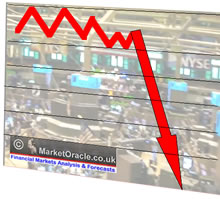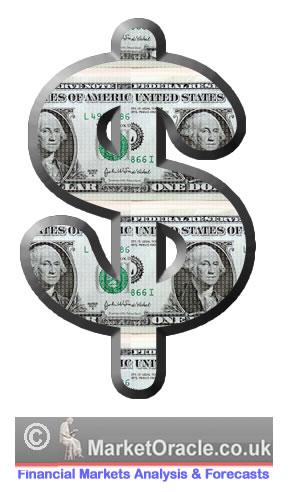Build Your Stocks Portfolio With Different ETF Weightings
Portfolio / Exchange Traded Funds Sep 17, 2009 - 08:24 AM GMTBy: Ron_Rowland
 You probably know that exchange traded funds (ETFs) are usually based on an index. In some cases the indexes are broad, like the S&P 500. Others are narrowly specialized in sectors like biotechnology or software. This means that ETF investors need to understand how indexes work.
You probably know that exchange traded funds (ETFs) are usually based on an index. In some cases the indexes are broad, like the S&P 500. Others are narrowly specialized in sectors like biotechnology or software. This means that ETF investors need to understand how indexes work.
So today I want to tell you about index weighting. This may sound like a dry subject, but it’s important. As you’ll see, different weighting strategies can make a big difference to your success.
What Do We Mean By “Weighting?”
Weighting is simply the way stocks are distributed in a portfolio. If, for instance, you have a million dollars and you decide to invest $300,000 in a stock, we would say you have a 30 percent weighting in that stock.
An index is nothing more than a publicly-available list of stocks that are weighted according to some sort of strategy. The S&P 500, for example, consists of 500 large U.S. stocks that are selected by a committee at Standard & Poor’s.
Like most indexes, the S&P 500 is “cap-weighted.” Each stock receives an allocation equal to its proportional market capitalization — the total value of all outstanding shares at the latest price.
We’ll use ExxonMobil (XOM) as an example. As of August 31, 2009, all of the shares of XOM put together were worth about $337 billion. Do this same calculation with the other 499 companies in the S&P 500, and the sum total was almost $9 trillion.
This means that ExxonMobil was roughly 3.8 percent of the total value of the S&P 500 on that day. If you owned an ETF based on the S&P 500, such as the SPDR Trust (SPY), you essentially had 3.8 percent of your money in XOM. The rest was split among the index’s other stocks.
With hundreds of stocks in the index, it’s obvious that a few large companies like XOM dominate the portfolio. The remaining ones get very small allocations — a fraction of a percent in most cases.
This is the drawback to cap-weighted indexing: The bigger companies get an outsize share. That’s great if those companies perform well, but not so great if they run into trouble.
To address this problem — and hopefully attract investors — some ETF sponsors have developed alternative weighting schemes. None are perfect, of course, but they can be very useful at times. Here are five for you to consider:
Alternative #1: Equal Weighting
This approach is strikingly simple: Just divide the money between all the stocks in an index equally. If your index consists of 50 stocks, each one gets 2 percent.
 |
| Equal weighting treats all stocks the same. |
Equal weighting was pioneered by Rydex, which offers a series of ETFs using this methodology. Rydex S&P Equal Weight ETF (RSP) owns the same stocks as the S&P 500 but with equal-weighting rather than cap-weighting.
Comparing SPY vs. RSP reveals how big the difference in returns can be …
In the first eight months of 2009, SPY (including dividends) was up 15 percent. RSP gained 29 percent during the same period.
How does this happen?
The smaller-cap stocks get a bigger weighting in RSP than they do in SPY. And those stocks have done generally better this year than most of the mega-cap issues. This isn’t always the case. But equal weighting clearly had a huge positive impact so far this year.
In addition to RSP, here are some other equal-weighted ETFs you might want to consider:
- SPDR S&P Biotech ETF (XBI)
- First Trust Nasdaq-100 Equal Weighted Fund (QQEW)
- SPDR S&P Semiconductor ETF (XSD)
Alternative #2 and #3: Dividend and Earnings Weighting
If you love income, then you’ll probably want to tilt your portfolio toward the stocks with a record of growing their dividends. So take a look at the ETFs offered by WisdomTree.
WisdomTree argues that, by design, cap-weighted ETFs are forced to buy high and sell low. Here’s why that’s true:
The higher a stock’s market capitalization (shares outstanding multiplied by the share price), the more shares a cap-weighted ETF buys. If those share prices decline, the market capitalization of the stock declines as well. Consequently, they are replaced with higher-cap stocks when the ETF rebalances its portfolio.
WisdomTree’s solution is a set of indexes that use fundamental factors like dividends and earnings to allocate among stocks. They think this will lead to better long-term results, and they have a lot of research to support their point.
 |
| Fundamental factors are more objective than stock prices. |
One advantage of this approach is that dividends and earnings are much more objective than stock prices as a way of measuring a company’s success. We’ve all seen stocks launched into orbit by irrational investors chasing surging stock prices, only to come crashing back down.
Dividends aren’t so easily manipulated. And screening for companies with consistent earnings can help weed out the money-losing and speculative ones.
WisdomTree has a whole family of ETFs that follow variations on this theme. Some of the most popular are:
- WisdomTree Dividend excluding Financials (DTN)
- WisdomTree India Earnings Fund (EPI)
- WisdomTree Emerging Markets SmallCap Dividend (DGS)
Alternative #4: Revenue Weighting
Another methodology is offered by a company called RevenueShares. The name gives away their strategy: Stocks in their ETFs are weighted by revenue.
Revenue is even more resistant to manipulation than earnings. In accounting lingo, it’s the “top line” of money coming in. Public companies are required to disclose it in their SEC filings, so the information is readily available.
 |
| Revenue is what makes companies grow. |
RevenueShares says that weighting stocks by their revenue can deliver attractive returns over time. Though of course it doesn’t mean their strategy will work all the time. Here are some of the best-known RevenueShares ETFs:
- RevenueShares Small Cap (RWJ)
- RevenueShares Mid Cap (RWK)
- RevenueShares Large Cap (RWL)
Alternative #5: Combinations of Fundamental Weightings
Alternatives #2 — #4 discussed above are sometimes referred to as fundamental weighting. Rob Arnott, of Research Affiliates, has created fundamentally weighted indexes using a combination of factors such as sales, book value, dividends, and cash flow. And he has teamed up with FTSE to offer the FTSE-RAFI indexes.
Some of the ETFs using this approach include:
- PowerShares FTSE-RAFI US 1000 (PRF)
- PowerShares FTSE-RAFI Emerging Markets (PXH)
- PowerShares FTSE-RAFI US 1500 Small-Mid (PRFZ)
For longtime investors, cap-weighting is what they know. And that may describe you, too. After all, it’s familiar. But staying open to new ideas can pay off in the long run. So take a look at these alternative-weighting strategies … you may find something you really like.
Best wishes,
Ron
P.S. I’m now on Twitter. Please follow me at http://www.twitter.com/ron_rowland for frequent updates, personal insights and observations about the world of ETFs.
If you don’t have a Twitter account, sign up today at http://www.twitter.com/signup and then click on the ‘Follow’ button from http://www.twitter.com/ron_rowland to receive updates on either your cell phone or Twitter page.
This investment news is brought to you by Money and Markets . Money and Markets is a free daily investment newsletter from Martin D. Weiss and Weiss Research analysts offering the latest investing news and financial insights for the stock market, including tips and advice on investing in gold, energy and oil. Dr. Weiss is a leader in the fields of investing, interest rates, financial safety and economic forecasting. To view archives or subscribe, visit http://www.moneyandmarkets.com .
Money and Markets Archive |
© 2005-2022 http://www.MarketOracle.co.uk - The Market Oracle is a FREE Daily Financial Markets Analysis & Forecasting online publication.



